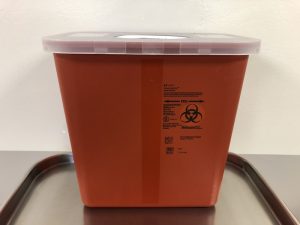Skill Group: Biosafety and Biosecurity
Disposal of PPE
Before You Start …
You have previously learned about how to select appropriate PPE items given an anticipated pathogen transmission risk and how to don and doff these items. Now, we will discuss effective disposal of used PPE items.
Introduction
You’ve done the hard part – chosen the appropriate PPE items to wear for a given situation and donned and doffed them correctly so that you did not contaminate yourself or the environment. But equally important is proper disposal of these items to ensure pathogen contamination does not occur.
Learning Outcomes
By the end of this lesson, you should be able to:
- Identify key elements of proper disposal of PPE.
What is considered medical waste?
Medical waste is defined by the EPA as “any solid waste that is generated in the diagnosis, treatment, or immunization of human beings or animals, in research pertaining thereto, or in the production or testing of biologicals.” Medical waste is regulated at the state level. The Ohio EPA states that some veterinary wastes must be disposed of using Biohazard bins, including the following:
- Carcasses, tissues, organs, body parts, and any other pathological wastes from animals that died due to a zoonotic or infectious agent.
- Bedding and wastes from the enclosures of animals that have been isolated because of a diagnosed zoonotic disease.
- Any other waste materials the veterinarian designates as infectious wastes.
Therefore, not all used PPE must be disposed of in biohazard bins (e.g., a veterinarian uses PPE on a patient that has not been diagnosed with a zoonotic disease AND (s)he does not consider infectious or does not consider the PPE to be contaminated/source of infection).
However, given the risks of improperly disposing of contaminated PPE, all used PPE at the Ohio State University (and at many other facilities) is considered infectious waste and disposed of in biohazard bins. In the field (e.g., equine barn, farm call), veterinarians should carry empty biohazard bags into which they can place infectious waste (including PPE) and transport back to their facility for proper disposal.
Correct disposal of used PPE items
Correct disposal of used PPE items is relatively simple. But there are a few key things to remember to ensure you do not undo the infection control work you have accomplished through PPE use.
- Used items should IMMEDIATELY be placed in the designated biohazardous waste (or disinfectant bin for reprocessing if being reused at a later date). Failure to do this immediately results in opportunities to contaminate yourself or the environment. As such, designated biohazardous waste bins should be easily accessible in locations where PPE doffing is to occur.
- Used PPE should be considered biohazardous and as such placed in a designated biohazardous waste receptacle. Such receptacles should be lined with a plastic bag, appropriately labeled as biohazardous.

Image: A sharps bin Special care should occur with this waste, including:
- Removal and replacement with an empty bag before items overflow.
- Double bagging and considering additional measures (e.g., transported in a manner and route to reduce contamination) if a bag is inadvertently punctured or spills material.
- Following specific federal and local requirements surrounding biohazardous waste removal and disposal.
- IMMEDIATELY perform hand hygiene (wash hands with soap and water or use an alcohol-based hand sanitizer) when it is likely you have contaminated your hands when disposing of PPE items.
Wrapping Up
You now have the knowledge to choose the appropriate PPE for a situation and effectively don, doff and dispose of used PPE items in a manner that reduces pathogen contamination. Be sure to practice all of these steps to ensure you have mastered these critical clinical infection control skills to best protect your patients, staff, clients and yourself.